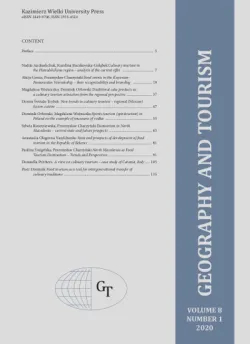Weight of diagnostic characteristics in the assess ment of tourism potential of rural areas according to Siedlce inhabitants
DOI:
https://doi.org/10.34767/GAT.2021.09.03Słowa kluczowe:
rural tourism, cultural advantages, natural advantages, tourist-oriented infrastructureAbstrakt
The presented work is an attempt to determine the importance of individual diagnostic characteristics conditioning rural tourism development by calculating their weights. The research was conducted in 2020 and involved the inhabitants of the city of Siedlce. The research method comprised a diagnostic survey. The authors’ research tool of choice was a questionnaire. The research pertained to an assessment of characteristics reflecting the tourism potential of rural areas in Poland. Evaluation of attitudes was based on a 10-grade Likert scale. The resulting point scores were used to calculate weights of characteristics affecting tourism development in rural areas. The characteristics representing structural resources which had the greatest impact on rural tourism development included: presence of natural water bodies in the commune, number of historic sites,
number of food and beverage serving establishments, convenient road access to the commune’s administrative centre, and distance between the locality and the nearest town whose population exceeds 20 thousand inhabitants. Considering functional resources, indicators which may enhance an area’s attractiveness to tourists include commune’s ability to obtain EU funds and their expenses on tourism and entrepreneurship.
Bibliografia
Gołębski G., 2002. Metody stymulowania rozwoju turystyki w ujęciu przestrzennym. Wydawnictwo Akademii Ekonomicznej w Poznaniu, Poznań [In Polish].
Hakuć-Błażowska A., Pacek N., Kupren K., Furgała-Selezniow G., 2018. Comparison of Tourist Attractiveness of Rural and Urban-rural Communes of Elbląg Country. Studia Obszarów Wiejskich 50, 81-99 [In Polish with English Abstract].
Kaczmarek J., Stasiak A., Włodarczyk B., 2005. Tourist Product. Polskie Wydawnictwo Ekonomiczne, Warszawa [In Polish with English Abstract].
Marciniuk-Kluska A., 2014. Tourism as a Determinant of Rural Development. Zeszyty Naukowe Uniwersytetu Przyrodniczo-Humanistycznego w Siedlcach, Seria: Administracja i Zarządzanie 101, 85-100 [In Polish with English Abstract].
Pukowiec K., Kurda W., 2013. Evaluation of the Tourist and Recreational Attractiveness of the Communes in the Country of Lubliniec. Zeszyty Naukowe Wyższej Szkoły Przymierza Rodzin w Warszawie 11, Seria geograficzno-turystyczna 6, 7-20 [In Polish with English Abstract].
Rural areas in Poland in 2018, 2020. Statistics Poland, Statistical Office in Olsztyn.
Sawicki B., Mazurek-Kusiak A., 2010. Agroturystyka w teorii i praktyce. Wydawnictwo Uniwersytetu Przyrodniczego w Lublinie, Lublin [In Polish].
Sikora J., Jęczmyk A., 2005. Czynniki wspierające i bariery ograniczające rozwój agroturystyki. [In:] Sawicki B., Bergier J. (Eds.), Uwarunkowania rozwoju turystyki związanej z obszarami wiejskimi. Wydawnictwo Państwowej Wyższej Szkoły Zawodowej w Białej Podlaskiej, Biała Podlaska, 37-45 [In Polish].
Tucki A., 2009. Tourist Potential of the Lublin Region. Annales Universitatis Mariae Curie-Sklodowska sectio B – Geographia Geologia Mineralogia et Petrographia 64(1), 15-35 [In Polish with English Abstract].
Zajadacz A., Śniadek J., 2009. Ocena potencjału turystycznego. [In:] Młynarczyk Z., Zajadacz A. (Eds.), Uwarunkowania i plany rozwoju turystyki, Tom 3. Walory i atrakcje turystyczne. Potencjał turystyczny. Plany rozwoju turystyki. Seria Turystyka i Rekreacja – Studia i Prace Nr 3, Uniwersytet im. Adama Mickiewicza w Poznaniu, 35-59 [In Polish].

